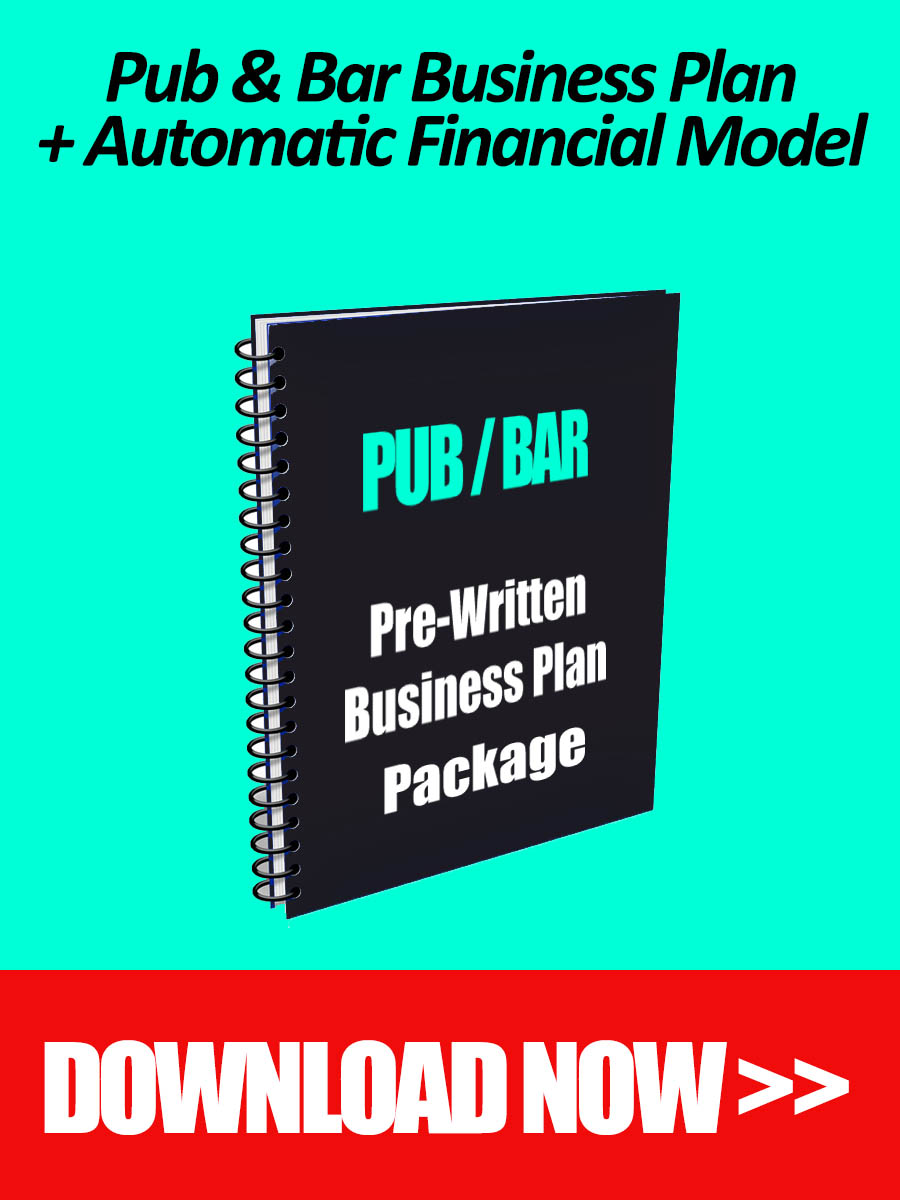Embarking on the journey of opening a bar is a thrilling venture, filled with the promise of convivial nights and the creation of a vibrant social hub. Yet, beneath the allure of clinking glasses and laughter lies the strategic foundation that will either elevate or impede your venture—the business plan. In the dynamic realm of hospitality, where every concoction and ambiance detail matters, a well-crafted bar business plan becomes the compass steering your project towards prosperity. This article – written by our business planning experts with over 15 years of experience helping F&B and bar owners launch successful ventures – navigates the intricacies of drafting a compelling bar business plan, unraveling the crucial steps to transform your vision into a thriving reality.
Whether you’re a seasoned entrepreneur or a first-time bar owner, a business plan is your blueprint, guiding decisions and attracting potential investors. It’s not just a document; it’s your narrative—a story that convinces others to join your pursuit of mixology and merriment. This guide aims to demystify the process, helping you weave together the essential elements that will set the stage for a successful bar business. So, let’s embark on this expedition, where the pen is your sword, and the business plan, your map to the bustling kingdom of nightlife entrepreneurship.
Ready-Made Bar Business Plan Template with Financials
Before we start, we would like to announce that you can now download our ready-made bar business plan template in Word with automatic financials in Excel. This off the shelf and cost-effective solution will help you create a solid and investor-grade business plan for your bar project in record time even if you have very little financial knowledge. Check it out now.
Bar Business Plan: The Business Concept
Now, let’s delve into the heart of your venture—the unique concept that will distinguish your bar in a sea of entertainment options. Your business concept is the DNA of your establishment, encapsulating its soul and setting the tone for the entire experience. Begin by vividly describing your bar’s atmosphere, theme, and the emotions you want patrons to feel as they step through the door.
Consider your target audience—those you envision sharing stories over crafted cocktails or dancing to curated beats.
What sets your bar apart? Is it the artisanal approach to mixology, an immersive theme, or a fusion of diverse cultural influences?
Define the essence of your bar, ensuring it resonates with the desires and preferences of your intended clientele.
Understanding your customer profile is key. Is your bar a chic lounge attracting young urban professionals, or a cozy pub catering to a more laid-back crowd?
A nuanced comprehension of your audience will shape not only your offerings but also your marketing strategy. As you embark on this conceptual journey, remember: a well-defined business concept is the compass guiding patrons to your unique oasis in the vast landscape of nightlife options.
Market Analysis for Your Bar Business Plan
The market analysis section of your bar business plan is the compass that points to opportunities and navigates potential challenges.
Begin by surveying the broader bar industry, acknowledging trends, and recognizing patterns that could impact your business. Dive into your local market—examine the competition, identify key players, and discern the unmet needs that your bar could fulfill. This section is not merely about numbers; it’s about painting a vivid picture of your business’s place in the market ecosystem.
It is mandatory to conduct a thorough competitor analysis, understanding their strengths and weaknesses. Uncover the gaps in the market that your bar can elegantly fill, offering something unique and compelling. Define your target market—age groups, preferences, and demographics—aligning your concept with the desires of those who will make your bar their preferred destination.
A bar SWOT analysis (Strengths, Weaknesses, Opportunities, Threats) is a powerful tool at this stage, providing a holistic view of your venture. By understanding these elements, you can position your bar strategically, harnessing strengths and mitigating weaknesses.
In essence, this section is your reconnaissance mission, arming you with the insights needed to steer your bar through the dynamic currents of the market.
Your Bar’s Operations and Management
With your bar’s concept and market dynamics firmly grasped, the spotlight now turns to the engine that propels your vision into reality—operations and management. This section is the backstage pass, providing a glimpse into the organizational structure, key players, and the synchronized dance that keeps your bar running seamlessly.
The first step here consists of outlining the organizational structure by defining the roles and responsibilities of each team member. From bartenders crafting liquid art to floor managers orchestrating the flow of patrons, paint a picture of the skilled individuals who will bring your vision to life. Emphasize the unique skills and experiences that each team member contributes.
Recruitment is a crucial aspect. Detail your strategy for assembling a team that not only possesses the requisite skills but also embodies the spirit of your bar. Whether you’re tapping into seasoned industry professionals or nurturing fresh talent, the success of your bar is intrinsically tied to the caliber of your team.
Ultimately, this section encapsulates the choreography of your operations. It’s about showcasing the skilled performers who will transform your bar from a concept on paper to a living, breathing entity—a place where every interaction, every pour, and every detail contributes to the symphony of a memorable night out.
Your Bar’s Products and Services
Now that the stage is set and the curtain is ready to rise, it’s time to showcase the stars of your show—your products and services. This section is the menu of experiences you’ll be serving to your patrons, encapsulating the essence of your bar’s identity.
This section should provide a comprehensive menu overview, detailing the range of beverages and offerings that will tantalize the taste buds of your clientele. Whether it’s artisanal cocktails, curated wine selections, or a unique selection of craft beers, it is a good idea to articulate the flavors and experiences your bar promises.
Make sure to highlight your signature offerings and specialty drinks—these are the showstoppers that will not only entice first-time visitors but keep patrons coming back for more. Consider the presentation, the ingredients, and the stories behind each concoction; after all, a great drink is not just a beverage but a narrative in a glass.
Next, your bar’s pricing strategy. You need to balance affordability with the perceived value of your offerings. Be transparent about the costs associated with your products, ensuring that your pricing aligns with your target market’s expectations while sustaining the profitability of your business.
Lastly, you need to provide insights into your suppliers and inventory management. Establishing reliable partnerships with suppliers ensures a consistent flow of high-quality ingredients, while effective inventory management prevents wastage and maximizes profitability.
Bar Business Plan: Marketing and Sales Strategy
This section is the promotional melody, orchestrating the symphony that turns a casual passerby into a devoted regular.
Your Bar’s Branding and Positioning
Here you need to describe the identity of your bar. What emotions do you want associated with your brand? Is it a trendy hotspot, a cozy hideaway, or a fusion of eclectic vibes? Define your brand’s personality and weave it into every aspect of your marketing collateral—from your logo to your social media presence.
Marketing Channels and Promotional Activities
Next, describe the channels through which you’ll communicate with your audience. In the digital age, social media is often a powerful ally; however, don’t underestimate the impact of traditional channels such as local partnerships, events, and word-of-mouth. Develop a content calendar that aligns with your brand narrative, utilizing a mix of engaging visuals, storytelling, and promotions to keep your audience captivated.
Also make sure to include launching promotional activities to create buzz during the opening phase. Special events, happy hour discounts, or exclusive tastings can act as magnets, attracting curious patrons eager to experience the novelty your bar promises.
Sales Forecast
No business can thrive without a proper sales strategy and bars and pubs are no exception. In this section, provide a realistic sales forecast that reflects your understanding of the market demand, pricing strategy, and promotional efforts. This is the crystal ball that investors and stakeholders will peer into, gauging the potential success of your bar. Ground your projections in market research, historical data if available, and the unique value proposition your bar brings to the table.
Your Bar’s Financial Plan
We cannot emphasize enough the importance of including a robust financial plan. This is probably the section that will draw the most attention from your readers or potential investors so make sure you nail it.
Let’s go.
Startup Costs
Start by outlining the initial investment required to turn your concept into a reality. This includes costs such as lease or purchase of the venue, interior design, licensing, permits, equipment, initial inventory, marketing expenses for the launch, and any other upfront expenditures.
Funding Requirements
Clearly articulate your funding needs. Whether you’re relying on personal savings, loans, investors, or a combination, provide a transparent breakdown of how you plan to finance your venture. This section is crucial for potential investors who want to understand the commitment and financial structure of your bar.
Your Bar’s Financial Projections
Based on your sales forecast (which we discussed above), your market analysis and pricing strategy, it is now time to generate detailed financial projections for your bar project. Projections should cover at least the first three years, offering a glimpse into the expected revenue and expenses. Break down the projections into monthly or quarterly intervals, showcasing the seasonality or trends in the bar industry.
You will also need to include a profit and loss statement, cash flow forecast, and balance sheet. These financial statements provide a comprehensive view of your bar’s financial health, helping you and potential investors understand how the business will generate revenue, manage expenses, and maintain liquidity.
For more information on this, we highly recommend you consult the financial plan guides section on our website.
Break-even Analysis
Define the point at which your bar will break even—when total revenue equals total costs. This analysis provides a crucial benchmark, helping you understand when your business is expected to become profitable. It also offers insights into the level of sales needed to cover your operational costs.
Risks & Contingency Plan
It is a good idea to include a section on risk management. Outline specific contingency plans for the most critical risks your venture may face. This could involve having backup suppliers, building a financial reserve for unexpected expenses, or implementing flexibility in your operations to adapt quickly to changing circumstances. The ability to pivot in response to challenges is a hallmark of a resilient and successful business.
Conclusion
As the final curtain falls on this exploration of crafting a business plan for your bar, it’s time to distill the essence of your venture into a compelling conclusion. This section serves as the encore, leaving readers with a lasting impression and a call to action.
Summary of Key Points
Summarize the key elements discussed throughout the business plan. Revisit the unique concept, the market analysis insights, the operational intricacies, the enticing products and services, the marketing symphony, the financial composition, and the resilience woven into your risk analysis. Concisely restate the aspects that make your bar stand out in the competitive landscape.
Call to Action or Next Steps
Encourage readers to take the next steps. Whether it’s reaching out to potential investors, fine-tuning specific aspects of the business plan, or moving forward with the execution phase, provide a clear call to action. This could be an invitation to connect for further discussions, an announcement of your opening date, or an introduction to your crowdfunding campaign.
That’s it! We hope this detailed guide on how to build a solid business plan for a bar was useful. In case you are interested in a cost-effective solution, we highly recommend you check our ready-made bar business plan template. This is probably the quickest, most efficient way to create an investor-grade business plan for your bar venture.
Good luck!



